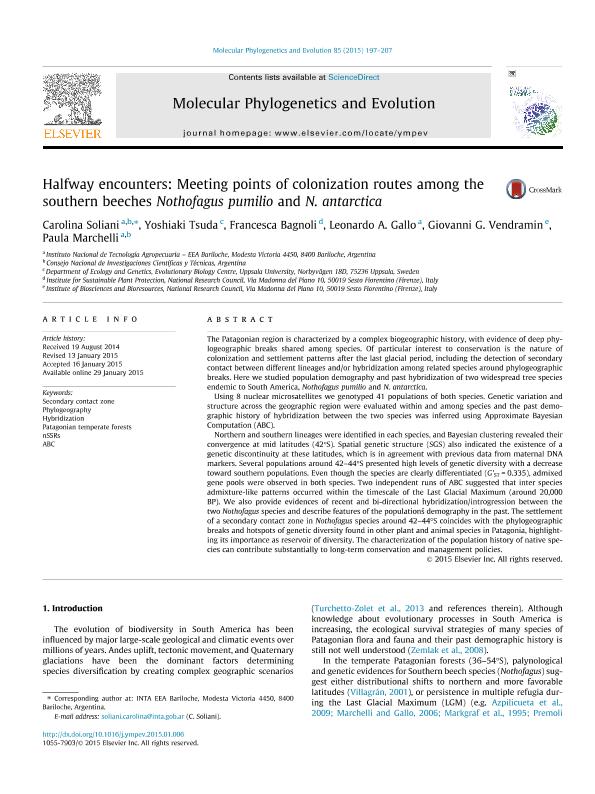Artículo
Halfway encounters: Meeting points of colonization routes among the southern beeches Nothofagus pumilio and N. antarctica
Soliani, Carolina ; Tsuda, Yoshiaki; Bagnoli, Francesca; Gallo, Leonardo; Vendramin, Giovanni G.; Marchelli, Paula
; Tsuda, Yoshiaki; Bagnoli, Francesca; Gallo, Leonardo; Vendramin, Giovanni G.; Marchelli, Paula
 ; Tsuda, Yoshiaki; Bagnoli, Francesca; Gallo, Leonardo; Vendramin, Giovanni G.; Marchelli, Paula
; Tsuda, Yoshiaki; Bagnoli, Francesca; Gallo, Leonardo; Vendramin, Giovanni G.; Marchelli, Paula
Fecha de publicación:
04/2015
Editorial:
Academic Press Inc Elsevier Science
Revista:
Molecular Phylogenetics and Evolution
ISSN:
1055-7903
Idioma:
Inglés
Tipo de recurso:
Artículo publicado
Clasificación temática:
Resumen
The Patagonian region is characterized by a complex biogeographic history, with evidence of deep phylogeographic breaks shared among species. Of particular interest to conservation is the nature of colonization and settlement patterns after the last glacial period, including the detection of secondary contact between different lineages and/or hybridization among related species around phylogeographic breaks. Here we studied population demography and past hybridization of two widespread tree species endemic to South America, Nothofagus pumilio and N. antarctica.Using 8 nuclear microsatellites we genotyped 41 populations of both species. Genetic variation and structure across the geographic region were evaluated within and among species and the past demographic history of hybridization between the two species was inferred using Approximate Bayesian Computation (ABC).Northern and southern lineages were identified in each species, and Bayesian clustering revealed their convergence at mid latitudes (42°S). Spatial genetic structure (SGS) also indicated the existence of a genetic discontinuity at these latitudes, which is in agreement with previous data from maternal DNA markers. Several populations around 42-44°S presented high levels of genetic diversity with a decrease toward southern populations. Even though the species are clearly differentiated (G'ST=0.335), admixed gene pools were observed in both species. Two independent runs of ABC suggested that inter species admixture-like patterns occurred within the timescale of the Last Glacial Maximum (around 20,000 BP). We also provide evidences of recent and bi-directional hybridization/introgression between the two Nothofagus species and describe features of the populations demography in the past. The settlement of a secondary contact zone in Nothofagus species around 42-44°S coincides with the phylogeographic breaks and hotspots of genetic diversity found in other plant and animal species in Patagonia, highlighting its importance as reservoir of diversity. The characterization of the population history of native species can contribute substantially to long-term conservation and management policies.
Archivos asociados
Licencia
Identificadores
Colecciones
Articulos(CCT - PATAGONIA NORTE)
Articulos de CTRO.CIENTIFICO TECNOL.CONICET - PATAGONIA NORTE
Articulos de CTRO.CIENTIFICO TECNOL.CONICET - PATAGONIA NORTE
Citación
Soliani, Carolina; Tsuda, Yoshiaki; Bagnoli, Francesca; Gallo, Leonardo; Vendramin, Giovanni G.; et al.; Halfway encounters: Meeting points of colonization routes among the southern beeches Nothofagus pumilio and N. antarctica; Academic Press Inc Elsevier Science; Molecular Phylogenetics and Evolution; 85; 4-2015; 197-207
Compartir
Altmétricas



